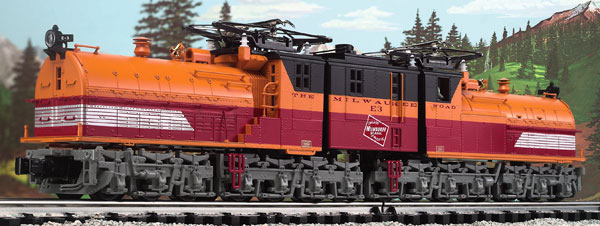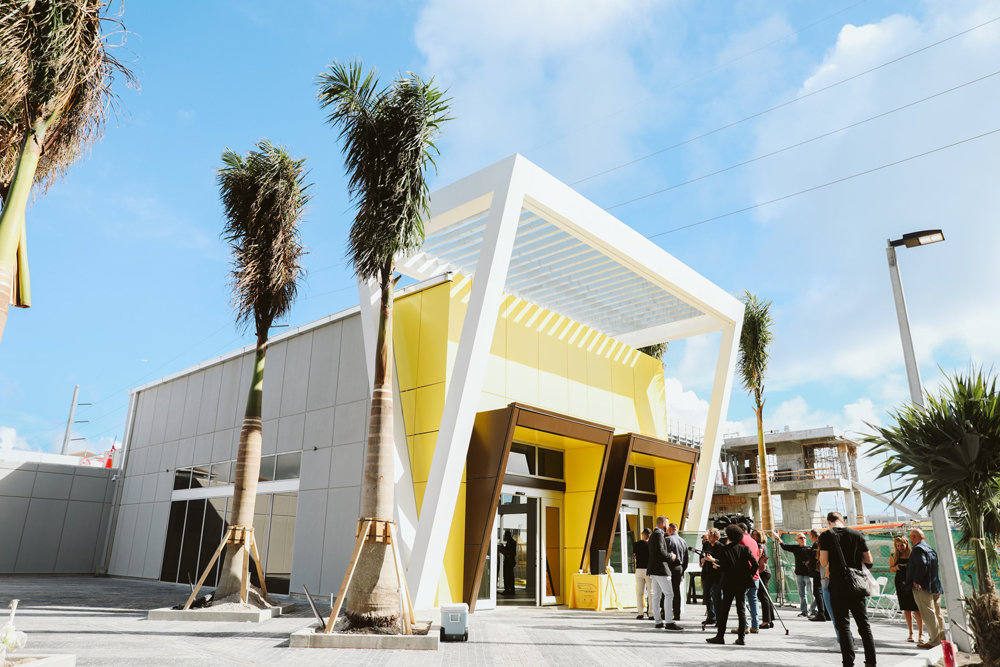Oddly, this singular engine was ignored in the postwar and modern eras, and now, on the brink of the Digital Era, we finally have MTH’s die-cast metal, scale model.
The prototypes were ordered from General Electric in 1917, after the Milwaukee Road decided to electrify its coast division. Five units were ordered, the first arriving in 1919.
The engines had 28 wheels and a flexible frame. The superstructure was built in three sections connected by diaphragms. The bipolars were gearless, the armatures of their traction motors were mounted directly to the axles, eliminating traction-motor gear whine. The motors were capable of generating 3,200 horsepower.
The ends of the bipolar’s body were rigidly mounted to the four-axle trucks beneath. The central cab section, containing a 3,600-gallon boiler and a fuel oil supply to heat passenger cars, was not connected to the trucks but was supported by the front and rear sections of the body. The engines were capable of hitting 90 mph, but 60 to 65 mph was normally the limit.
The locomotives had an exceptional service record, but by the 1950s time and poor wartime maintenance caught up with them. The Milwaukee Road’s Electrification Division rebuilt one of the locomotives at the railroad’s Tacoma, Wash., shop. The other units were rebuilt at the railroad’s Milwaukee, Wisc., shops, but crews there had little experience with electric locomotives and the job was poorly done. The bipolars went from queens to ugly step-sisters in short order. By 1960, all units were in storage. Four were scrapped and one, no. E2, was donated to the St. Louis Museum of Transportation.
The model
If they’d run Down Under, Mel Gibson would have driven one of these puppies in the Mad Max movie Beyond Thunderdome. This is one studly brute.
The body reminds me of a loaf of bread cut into three pieces. The heavy die-cast metal shell is flawlessly tooled and has a significant amount of cast-in hinge, bolt, and vent detail. Add-on parts included handrails and grab irons literally all over the body. The running boards along the lower frame have a faintly visible safety tread pattern.
Unlike the real bipolar, the central cab section on the MTH model is connected to the running gear. Still, you won’t know this without a close inspection, since there are diaphragms connecting the front and rear body sections to the central section. The central section has an opening cab door although doors elsewhere are cast-in.
The die-cast metal side frames really stand out in their gray accent paint. The bipolar is a close second to MTH’s Centipede diesel in capturing my attention as its many wheels bob along layouts and through switches.
Rummaging for photos of the bipolar in the Kalmbach photo files was fun. Vintage black-and-white images reveal that these locomotives wore several paint schemes. The style of the MTH model seems to be spot on target. While I always joke that any engine would look better in my favorite New York Central colors, I’ve gotta tell you that the bipolar looks just fine in the brilliant orange Milwaukee Road paint scheme.
The bipolar is 20 inches long coupler-to-coupler (80 feet in O scale) compared to the prototype’s 76 feet (the difference accounted for by the oversized O gauge couplers).
On the test track
The bipolar delivered commendable performance. The low-speed average was 6 scale mph (which takes so long to get around the CTT test track that you can really get into the Muzak playing over our office building’s PA system). The high-end average was 87.3 scale mph. Drawbar pull was a robust 2 pounds, 7 ounces. With a 25-car mixed make and vintage train in tow I clocked the model at 61.7 scale mph.
Smoke unit? Okay, don’t think of it as a smoke unit. Think of it as a steam generator. This unit successfully mimics the bipolar’s oil-fired boiler used to keep passenger cars warm during their journey through the Cascades.
Let’s talk about sound. I found the ProtoSound 2.0 package pretty pleasing, but that having been said, several reference books suggest that the locomotive’s axle-armature arrangement made it virtually silent when under way except for obvious heavy-metal moving sounds. The PS2 package sounds more like a generic electric locomotive.
While I liked what I heard, (running at a very low speed, the locomotive sounded like the engine room of a ship), the sounds might irritate a handful of electric or Milwaukee Road fans who have actually heard a bipolar in action.
There are certain ProtoSound 2.0 audio features that run in the conventional mode, such as cab-chatter, engine startup and shutdown, and squealing brakes, so you don’t need the Digital Control System (DCS) for some basic sound fun. CTT is still awaiting delivery of its DCS hardware, so we were able to test the bipolar’s features only in conventional mode.
The conventional features performed well. You can fire the front or rear couplers, turn the cruise control on and off, or lock the engine in a single direction by manipulating the bell and horn controls. This is a heck of a lot easier than the old clink and clank manipulation of ProtoSound 1.0.
The bipolar is a locomotive that few would have expected to see in O gauge, let alone produced in die-cast metal. This engine will look unlike anything on your layout (well, anything on your layout made after 1938, let’s say), and you’ll probably wish you had some O scale mountains for this baby to haul some heavy trains over!














